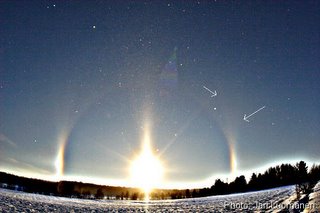 |
| average stack of 15 frames |
In the morning after new year's night, I noticed through a window cirrus clouds, and I went to observe. While I was waiting for the appearance of halos, I noticed weak subparhelia on the ice surface. Out of curiosity, I decided to look for a place where they could be brighter, and I found it (1, 2). It was quite a small area near a coast, almost all sides limited. There I saw not only bright subparhelia, but also clearly visible sub 120° parhelion in pillar form.
 |
| maximum stack of 3 frames |
It was perfectly visible even when I did not move. The temperature was negative only at night until this morning. In the previous day it was positive (around +4 degrees of Celsius), as during of the observation (0...+1).
At that time, while I was shooting halos on the ice surface, in the sky appeared parhelion and 22 degree halo (3). Later the upper tangent arc was spotted in cirrus clouds (on the stack also well visible supralateral arc - 4). At the end of the day, I also noticed weak and wide circumzenithal arc (5) from low sun.
Date: 2017-01-01




